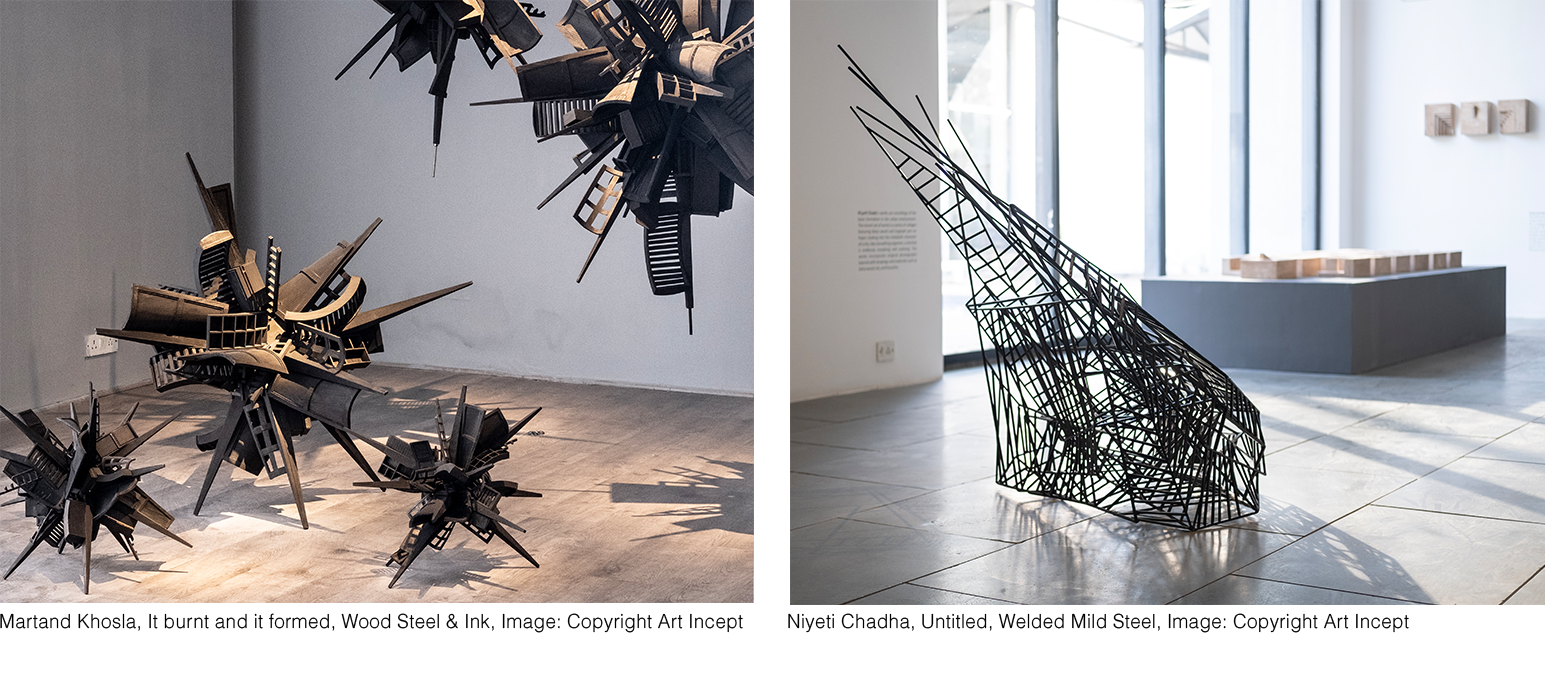“There are two kinds of light- the glow that illuminates, and the glare that obscures.” – James Thurber
Art Galleries are not just displays of artworks, but also an adventure for the viewers to explore and discover. This experience is made possible through a curated placement of artwork, with thoughtful lighting. Art Incept’s ongoing presentation titled Spaced Out, the lighting done by Vis A Vis, is the perfect example of art and light working in uniformity to create a brilliant experience that stimulates curiosity and wonderment in the audience. Curated by our consulting curator Rahul Kumar, the exhibition delves into the idea of space and the emotions it evokes, by bringing together eight contemporary artists who explore these notions through their works. The lighting provides the perfect ambience for the audience to enjoy and engage with the artworks.

Flexibility of lighting in Art Galleries
Flexibility of lighting is an important requirement, specifically in the context of art galleries. Artworks in galleries, especially those in temporary exhibitions are ever-changing in terms of placement, structures, size, material, colour and texture to mention a few, and all these factors influence the position, brightness and colour of the lights. Art galleries, therefore, use tracks where spotlights with various effects and illuminations can easily be popped in and out as needed. At Spaced Out spotlights have been used to accentuate the complex details of the artworks as well as to create dynamism in the exhibition. The use of different oval beams for Pratap Morey’s artworks is a great example. The narrow oval beam created by the lens brings attention to the intricate details of his works while the wide oval beam blends them with the wall giving it a uniform look.
The placement of tracks on the ceilings is another aspect to consider when lighting art in an art gallery environment. The height of the wall as well as the location/placement of artworks factor into where the track lights are set. The lights are ideally placed at an angle known as the ‘museum angle’, which is 30° from the ceiling and directed towards the work intended to light. This prevents the risk of exaggerated shadows that happen when tracks are placed too close to the artworks. This also avoids a glare that may be distracting to the eye.
With light, one size does not fit all! The lighting technique is different for Abhishek Dhodiya’s wall-mounted installation. Here, a wall washer lens covers a wider area bringing the artworks in a single frame, and the double shadows created by the angled beam make the details more prominent.
Light: Colour and Temperature

The colour and temperature of light also have a strong influence on how the works are perceived. While there are various colour theories for lighting in relation to the display of objects, lights with neutral and balanced colours are most appropriate for art galleries to avoid distortion of how a work of art appears. It is also ideal to keep the intensity of lights in check as the colour of the artwork determines how brightly it ought to be lit. A light-coloured artwork requires less intensity to avoid visual discomfort as a result of contrast it would create for the eyes if too brightly lit, while a darker colour artwork may require a higher degree of illumination.
Another thing to keep in mind is the source of natural light in the gallery. Debashish Mukherjee’s work, for example, is well-lit during the daytime with the available natural light showing its intimate structure. Areas with natural lighting, however, need a different artificial light setting, specifically in terms of intensity so as not to create contrast with the rest of the exhibition space. It is also important to note that lighting is also one of the causes of the deterioration of artworks. Prolonged exposure to intense light can cause cumulative and irreparable damage to art objects depending on their sensitivity. The duration of the exhibition along with the level of light, therefore, should be calculated to ascertain the total exposure it will go through when planning for shows. Ideally, the level of illuminance is kept minimal for not only the preservation of art but also for viewing comfort.
Lighting of Three-Dimensional Artworks

Display of three-dimensional objects requires additional attention to either washout or accentuate the texture and add depth, as per the artist’s intent. In the case of Martand Khosla’s sculptures the lighting creates a dramatic and engaging experience where individual shadows for each sculpture are clearly visible. This is achieved with controlled beams that do not intersect or have secondary and tertiary beams avoiding the formation of multiple shadows of the same sculpture which can often be distracting. For M. Pravat’s sculpture, the emphasis is put on the intricacy of the artwork using three spotlights from different points highlighting all sides. The magic of natural lighting can be seen through Niyeti Chadha’s sculpture at the golden hour when the sunlight hits, creating an interesting shadow of the artwork and leaving the viewers in awe.

The critical duty of the lighting designer is to create an exciting space for the audience at the gallery. In an interview with Siddarth Singh, the managing partner at Vis a Vis, he states, “With controlled light, you can create hierarchies of perception which orient and guide the eye and make the viewers move around the space in the right direction without missing any work”. At Spaced Out, where the idea of space is provoked and analysed, the lighting also creates layers of orientation through controlled lighting making use of the space. The culmination of sophisticated placement of the artworks and lighting brings forth an exciting adventure for the audience to a dimension where space morphs into whatever they perceive.
About the Author
Khundongbam Ritu Devi works at Art Incept where she learns and appreciates the timeless value of contemporary art. As a museologist, her interest lies in preserving artworks and supporting artists connect with the general public.
